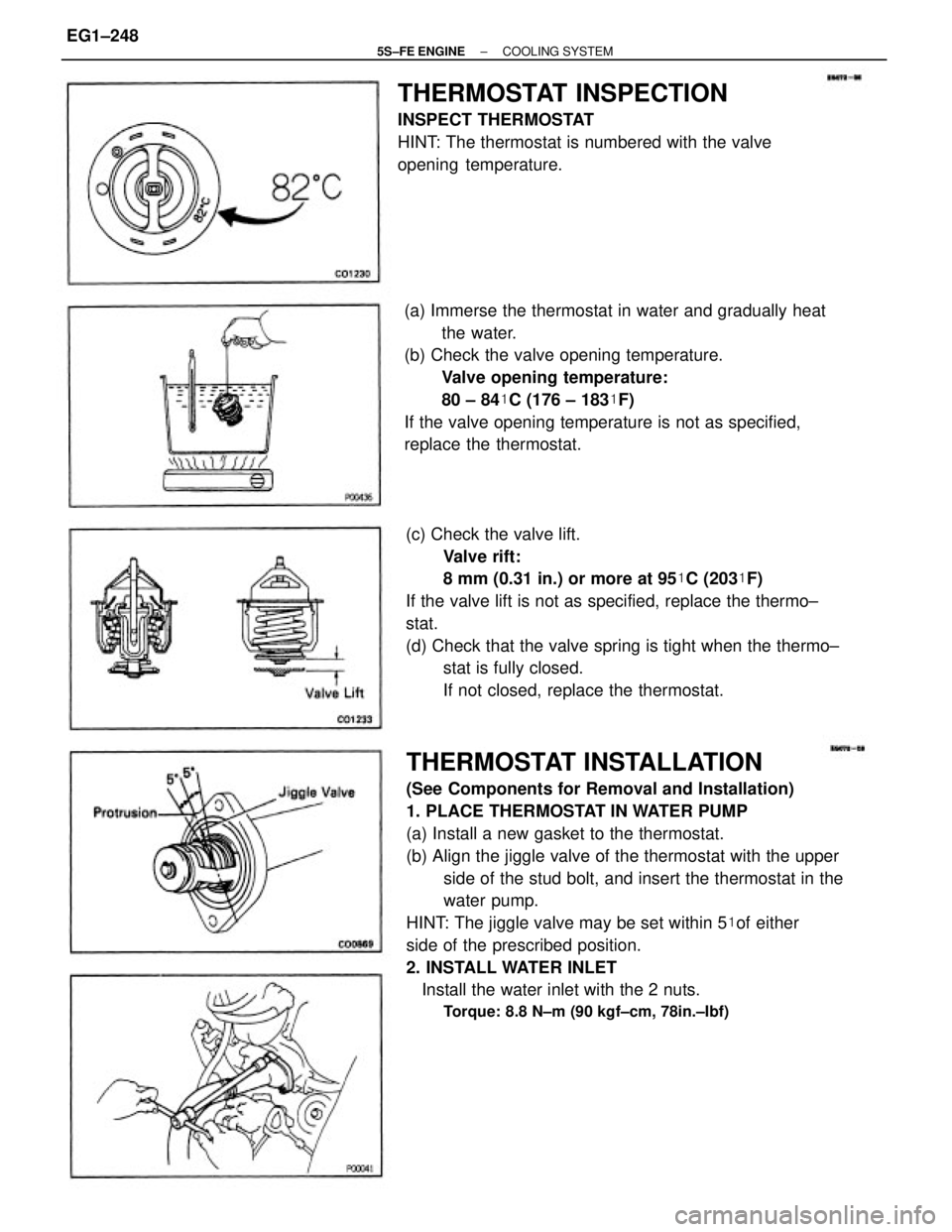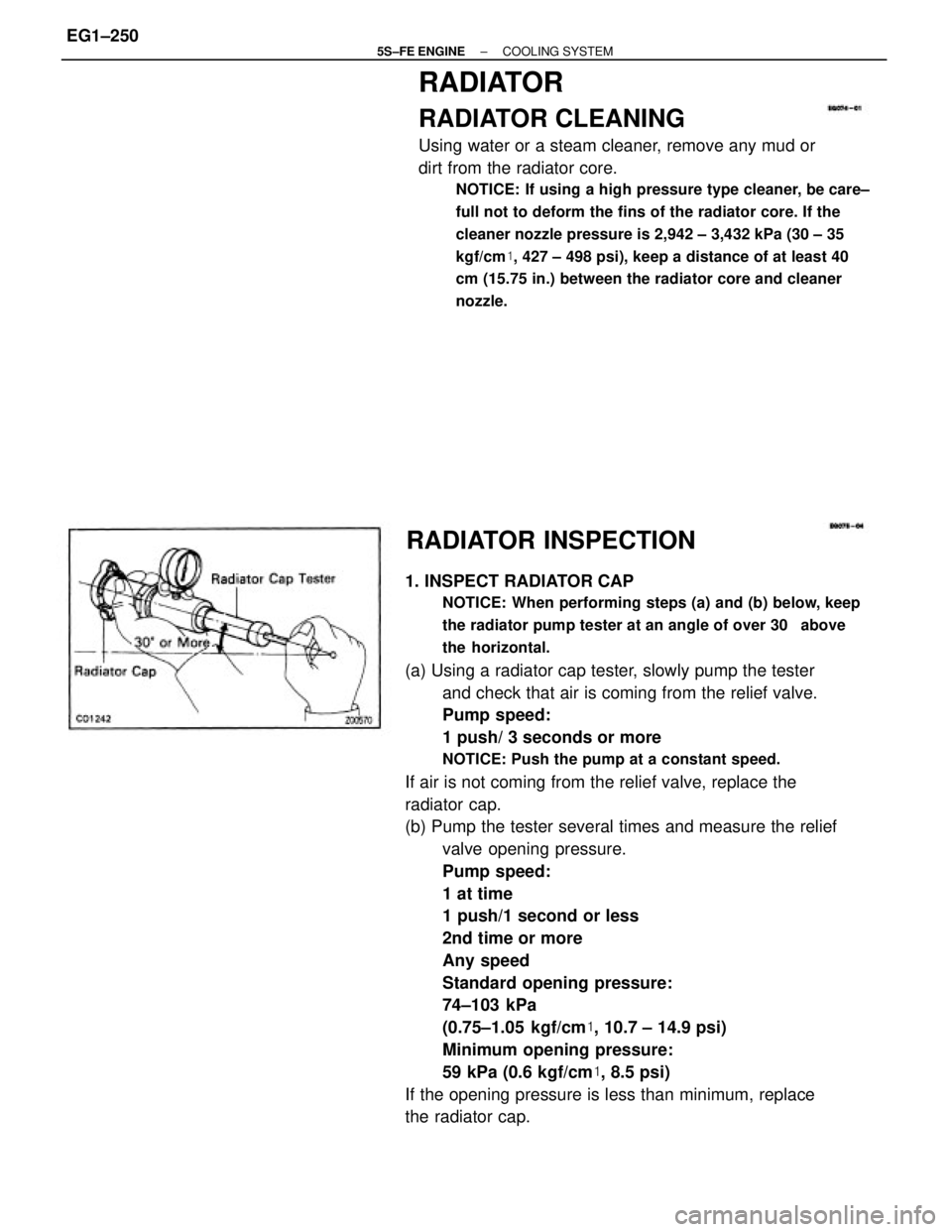Page 296 of 4770
7. TEMPORARILY INSTALL NO.1 IDLER PULLEY AND
TENSION SPRING
(a) Install the pulley with the bolt. Do not tighten the bolt
yet.
HINT: Use bolt 42 mm (1.65 in.) in length.
(b) Install the tension spring.
(c) Pry the pulley toward the left as far as it will go and
tighten the bolt.
(d) Check that the idler pulley moves smoothly.
8. INSTALL TIMING BELT (See page EG1±33)
9. CONNECT NEGATIVE (±) TERMINAL CABLE TO
BATTERY
10. FILL WITH ENGINE COOLANT
(See page EG1±241) 6. INSTALL NO.2 IDLER PULLEY
(a) Install the pulley with the bolt.
Torque: 42 N±m (425 kgf±cm, 31 ft±lbf)
HINT: Use a bolt 35 mm (1.38 in.) in length.
(b) Check that the idler pulley moves smoothly. 4. INSTALL GENERATOR BELT ADJUSTING BAR
Temporarily install the adjusting bar with the bolt.
5. CONNECT LOWER RADIATOR HOSE TO WATER
INLET (f) Install the 2 nuts holding the water pump cover to the
water bypass pipe.
Torque: 8.8 N±m (90 kgf±cm, 78 in.±Ibf)
± 5S±FE ENGINECOOLING SYSTEMEG1±246
Page 298 of 4770

THERMOSTAT INSTALLATION
(See Components for Removal and Installation)
1. PLACE THERMOSTAT IN WATER PUMP
(a) Install a new gasket to the thermostat.
(b) Align the jiggle valve of the thermostat with the upper
side of the stud bolt, and insert the thermostat in the
water pump.
HINT: The jiggle valve may be set within 5�of either
side of the prescribed position.
2. INSTALL WATER INLET
Install the water inlet with the 2 nuts.
Torque: 8.8 N±m (90 kgf±cm, 78in.±Ibf)
(c) Check the valve lift.
Valve rift:
8 mm (0.31 in.) or more at 95�C (203�F)
If the valve lift is not as specified, replace the thermo±
stat.
(d) Check that the valve spring is tight when the thermo±
stat is fully closed.
If not closed, replace the thermostat. (a) Immerse the thermostat in water and gradually heat
the water.
(b) Check the valve opening temperature.
Valve opening temperature:
80 ± 84�C (176 ± 183�F)
If the valve opening temperature is not as specified,
replace the thermostat.
THERMOSTAT INSPECTION
INSPECT THERMOSTAT
HINT: The thermostat is numbered with the valve
opening temperature.
± 5S±FE ENGINECOOLING SYSTEMEG1±248
Page 299 of 4770
7. CHECK ENGINE OIL LEVEL
The oil level should be between the ªLº and ªFº marks
on the dipstick.
If low, check for leakage and add oil up to ªFº mark. (c) Tighten the oil filter by hand until the rubber gasket
contacts the seat of the filter mounting. Then using
SST, give it an additional 3/4 turn to seat the oil filter.
SST 09228±06500
4. FILL WITH ENGINE OIL
5. FILL WITH ENGINE COOLANT (SEE PAGE EG1±241)
6. START ENGINE AND CHECK FOR LEAKS 3. INSTALL OIL FILTER
(a) Clean the oil filter contact surface on the filter
mounting.
(b) Lubricate the filter rubber gasket with engine oil.
± 5S±FE ENGINECOOLING SYSTEMEG1±249
Page 300 of 4770

1. INSPECT RADIATOR CAP
NOTICE: When performing steps (a) and (b) below, keep
the radiator pump tester at an angle of over 30� above
the horizontal.
(a) Using a radiator cap tester, slowly pump the tester
and check that air is coming from the relief valve.
Pump speed:
1 push/ 3 seconds or more
NOTICE: Push the pump at a constant speed.
If air is not coming from the relief valve, replace the
radiator cap.
(b) Pump the tester several times and measure the relief
valve opening pressure.
Pump speed:
1 at time
1 push/1 second or less
2nd time or more
Any speed
Standard opening pressure:
74±103 kPa
(0.75±1.05 kgf/cm�, 10.7 ± 14.9 psi)
Minimum opening pressure:
59 kPa (0.6 kgf/cm�, 8.5 psi)
If the opening pressure is less than minimum, replace
the radiator cap.
RADIATOR
RADIATOR CLEANING
Using water or a steam cleaner, remove any mud or
dirt from the radiator core.
NOTICE: If using a high pressure type cleaner, be care±
full not to deform the fins of the radiator core. If the
cleaner nozzle pressure is 2,942 ± 3,432 kPa (30 ± 35
kgf/cm�, 427 ± 498 psi), keep a distance of at least 40
cm (15.75 in.) between the radiator core and cleaner
nozzle.
RADIATOR INSPECTION
± 5S±FE ENGINECOOLING SYSTEMEG1±250
Page 301 of 4770
2. INSPECT COOLING SYSTEM FOR LEAKS
(a) Fill the radiator with coolant and attach a radiator cap
tester.
(b) Warm up the engine.
(c) Pump it to 118 kPa (1.2 kgf/cm�, 17.1 psi), and check
that the pressure does not drop.
If the pressure drops, check the hoses, radiator or
water pump for leaks. If no external leaks are found,
check the heater core, cylinder block and head.
RADIATOR REMOVAL
1. DISCONNECT NEGATIVE (±) TERMINAL CABLE
FROM BATTERY
CAUTION: Work must be started after 90 seconds from
the time the ignition switch is turned to the ªLOCKº
position and the negative (±) terminal cable is discon±
nected from the battery.
COMPONENTS FOR REMOVAL AND
INSTALLATION
± 5S±FE ENGINECOOLING SYSTEMEG1±251
Page 306 of 4770

2. INSPECT LOCK PLATE
Inspect the lock plate for damage.
HINT:
wIf the sides of the lock plate groove are deformed,
reassembly of the tank will be impossible.
wTherefore, first correct any deformation with pliers or
similar object. Water leakage will result if the bottom
of the lock plate groove is damaged or dented. There±
fore, repair or replace if necessary.
4. ASSEMBLE SST
SST 09230±01010
(a) Install the punch assembly to the overhaul handle,
inserting it in the hole in part ªAº as shown in the
illustration.
(b) While gripping the handle, adjust the stopper bolt so
that dimension ªBº shown in the diagram is 7.7 mm
(0.03 in.) 3. INSTALL NEW O±RINGS AND TANKS
(a) After checking that there are no foreign objects in the
lock plate groove, install the new O±ring without
twisting it.
HINT: When cleaning the lock plate groove, lightly rub
it with sand paper without scratching it.
(b) Install the tank without damaging the 0±ring.
(c) Tap the lock plate with a soft±faced hammer so that
there is no gap between it and the tank.
5. CAULK LOCK PLATE
(a) Lightly press SST against the lock plate in the order
shown in the illustration.
± 5S±FE ENGINECOOLING SYSTEMEG1±256
Page 307 of 4770
6. INSPECT FOR WATER LEAKS
(a) Tighten the drain cock.
(b) Plug the inlet and outlet pipes of the radiator with
SST.
SST 09230 ± 01010
(c) Using a radiator cap tester, apply pressure to the
radiator.
Test pressure:
177 kPa (1.8 kgf/cm�, 26 psi) (b) Check the lock plate height (H) after completing the
caulking.
Plate height:
7.75±8.25 mm (0±3051±0.3248 in.)
If not within the specified height, adjust the stopper
bolt of the handle again and perform the caulking
again.wThe points shown in the illustration and oil cooler
near here (A/T) cannot be staked with the SST.
Use a plier or like object and be careful not to
damage the core plates. After repeating this a few times, fully caulk the lock
plate by squeezing the handle until stopped by the
stopper plate.
SST 09230 ± 01010
HINT:
wDo not stake the areas protruding around the
pipes, brackets or tank ribs.
± 5S±FE ENGINECOOLING SYSTEMEG1±257
Page 308 of 4770
(d) Inspect for water leaks.
HINT: On radiators with resin tanks, there is a clear±
ance between the tank and lock plate where a minute
amount of air will remain, giving the appearance of an
air leak when the radiator is submerged in water.
Therefore, before performing the water leak test, first
switch the radiator around in the water until all air
bubbles disappear.
7. PAINT LOCK PLATES
HINT: If the water leak test checks out okay, allow the
radiator to completely dry and then paint the lock
plates.
RADIATOR INSTALLATION
(See Components for Removal and installation)
1. INSTALL ENGINE COOLANT TEMPERATURE
SWITCH
(a) Install a new O±ring to the engine coolant tempera±
ture switch.
(b) Install the engine coolant temperature switch.
2. INSTALL ELECTRIC COOLING FANS TO RADIATOR
Install the cooling fans with the 8 bolts.
3. INSTALL ENGINE COOLANT TEMPERATURE
SWITCH WIRE
± 5S±FE ENGINECOOLING SYSTEMEG1±258